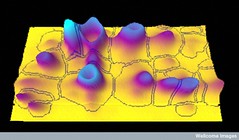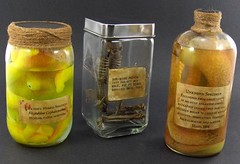When I hear the word ‘curator’ I usually think of museums. Museum curators are the sort of knowledge workers that take care of stuff in collections and make exhibition narratives possible.
Now I’ve just learned about another — different yet similar — kind of curators. The background is the current enormous growth in the generation of data from life science research. Large-scale sequencing, high-throughput gene-expression analyses, and mass-spectroscopy projects produce huge amounts of gene and protein sequences and other bio-data.
It doesn’t take much thinking to realise that the usefulness of all this data-generating research depends on the scientific community’s ability to make sense of the massive amounts of raw data scattered among millions of scientific papers and hundreds of data bases.
Here’s where the new kind of curators come into the picture. A recent article in Nature (Howe et al., ‘Big data: the future of biocuration’, 4 September) discusses the emergence of “a growing cadre of biologists — ‘biocurators’ — who manage raw biological data, extract information from published literature, develop structured vocabularies to tag data and make the information available online”.
When I read the article it struck me that there are some interesting similarities between museums curators and biocurators. A central aspect of data-curating is annotation — so far, however, says the Nature article, annotation efforts have been limited by a perceived lack of incentive to do the job: “A mechanism tied to career or research advancement may be required before community curation can be established as a broadly accepted and productive scientific endeavour.”
In other words, what is needed to speed up bio-curation is “improvement in academic reputation or impact, career advancement and better funding chances”. Further, academic departments and funding agencies “should consider community annotation as a productive contribution to the scientific research corpus and a natural extension of the publication process”.
Sounds like a parallell to the situation among museum curators. They too are working in the shadow of university scholars. Curatorial work in museums doesn’t have the same reputation as university research. So whether you work as a museum curator or as a bio-curator, you risk being invisible among ‘real’ researchers/scholars and suffering a lack of scholarly status.
Wonder if this has something to do with the fact that curatorial work is ‘care work’ (from Latin ‘cura’ = care)?
Read more in Nature’s special issue on ‘Big Data’ here.

 Tomorrow, Tuesday 9 September at noon, we’re having a lunch seminar with Sebastian Abrahamsson, doctoral student at Jesus College, University of Oxford. Sebastian will speak about ‘Dead bodies in science and art’ — a topic which is very central to our research and exhibition work here at
Tomorrow, Tuesday 9 September at noon, we’re having a lunch seminar with Sebastian Abrahamsson, doctoral student at Jesus College, University of Oxford. Sebastian will speak about ‘Dead bodies in science and art’ — a topic which is very central to our research and exhibition work here at 
 It allows you to find the image content of (presently) some 35,000 open access articles from
It allows you to find the image content of (presently) some 35,000 open access articles from  Ever thought about building your own collection of medical wet specimens? Spending your evenings and gloomy sleepless nights in the garage putting your family’s and friends’ pickled organs and body parts in jars? Founding a clandestine horror show?
Ever thought about building your own collection of medical wet specimens? Spending your evenings and gloomy sleepless nights in the garage putting your family’s and friends’ pickled organs and body parts in jars? Founding a clandestine horror show?